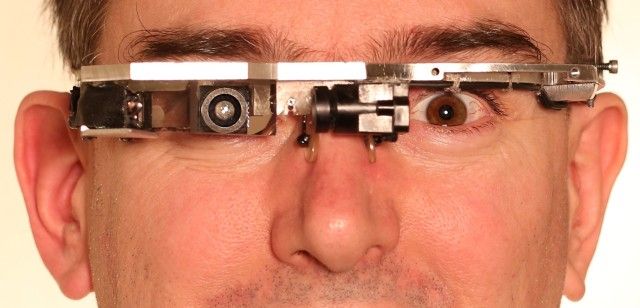"Sorry about the mess," says Steve Haworth, as we walk down the stairs to the surgical theater in his basement. My friend Ted is visibly pale and sweating – for good reason. He's about to get a sixth sense the hard way: by way of a scalpel, a needle and thread, and a tiny, gold-plated rare-earth magnet. Haworth is a body modification expert with a particular interest in what's called "biohacking" – the practice of merging consumer technology and the human body to produce uniquely functional body modifications.
Haworth pioneered the procedure that Ted is about to undergo – the implantation of a rare earth magnet into the flesh of his ring finger. Haworth has several already installed in his own body, which he shows us as he moves his hand through the air next to his running can opener. Sure enough, you can feel the magnet twitch and jump in response to the electromagnetic field generated by the motor. It's startling, and shows off exactly what you're getting for your three hundred and fifty dollars: the ability to feel the shape and strength of electromagnetic fields in the world around you. Our host describes someone who had the procedure done, and was startled, when walking through New York City, to discover the powerful electromagnetic field produced by an electrical junction under the sidewalk.
http://www.youtube.com/watch?v=kznWw1EcHXs
It's not just magnets, either. You can get a compass implant (called "SouthPaw") that moves to alert you when you're facing north. You can implant magnets in your ears and use a magnetic necklace to listen to music through your built-in speakers. Less ambitiously, you can get an RFID implant that unlocks your door, your phone, and your computer. Amal Graafstra, an implant enthusiast, uses his to open his safe, among other things:
We're the first to put near field communication (NFC) compliant implants on the market like this. [...] There are 880 bytes of space, relative to 97 in the previous generation, so before you could keep a name and phone number, but now it has far greater capacity.
For the squeamish, Motorola is developing an RFID pill that does the same thing. Not all of the experiments go well: Haworth related the story of a friend of his who had a neodymium magnet implanted in his wrist to hold his wristwatch on. Unfortunately, the pressure of the two magnets forced all of the blood out of his skin, and nearly killed the tissue. If this all sounds weird and crazy to you, remember: these are just the normal people.
On the crazy, transhumanist side of the equation, you've got people like Steve Mann and Kevin Warwick. Steve Mann is an inventor who works with augmented reality, and has been called "the father of wearable computing." He's been wearing various passthrough augmented reality devices for years. One of his later headsets looked like this:
His latest model isn't just fancy Google Glass - it's physically attached to his skull by several screws. It entirely captures the visual input to one eye, runs it through a computer to attach additional information, and then displays it on a small near-eye screen. Mann was the victim of what is arguably the first hate crime against a cyborg back in 2012, when McDonalds' employees attacked him while he was on vacation in France.
Warwick, another biohacking pioneer, is a professor of cybernetics at Coventry University. As part of "Project Cyborg," a medical and technological initiative launched and directed by Warwick, Warwick has undergone several surgical procedures to implant electronic devices into his body, including a 100-electrode sensor grid into the nerves in his elbow that feed his hand and arm. By capturing electrical signals flowing down his arm, Warwick was able to control a robotic wheelchair, and remote-control a robotic hand over the Internet. Later, his wife had a similar electrode grid implanted, allowing them to communicate with direct nerve impulses via the Internet. Warwick wants to push the forefront of human experience, and that means pushing the limits of the human form. In an interview with Forbes, he described what direct nerve-to-nerve communication with his wife feels like,
"It didn't feel like pain or heat or seeing. It was like an entirely new sense. And that was part of the experiment: to see if the brain can adapt and take on new types of input and learn to understand. The brain is very clever like that—I just want to see how far we can push it."
http://www.youtube.com/watch?v=VCYrW-G9Y6I
These "DIYBorgs" are, in many ways, just following in the footsteps of the experimental medicine community, which has been trying to address disabilities with cybernetic implants for years. Most forms of total deafness are curable these days, via the use of a cochlear implant -- a chip implanted in the nerves of the ear that uses several electrodes to translate sounds from a worn microphone into electrical signals to the brain. The audio quality is not as good as in a normal ear, but electrode densities are improving, and modern cochlear implants are good enough to understand speech without lip reading in a quiet room, and even to appreciate music (though audiophiles will probably complain about the bitrate). This is what it sounds like to listen to speech using existing cochlear implants:
http://www.youtube.com/watch?v=00WOao4kpwM#t=208
Even more ambitiously, scientists have reverse-engineered the retina, and created a computer program that reproduces its operation. This allows you to connect cameras to the optic nerve as though they were living eyes, and have the cameras speak to the brain on its own terms, providing a much more natural approximation of normal vision than has otherwise be possible. In principle, these cameras could eventually exceed human vision - implementing optical zoom, active night vision, and the ability to see the non-visible portions of the spectrum.
Back in the basement surgical studio, Haworth discusses his sterilization procedure while he gathers gloves, disinfectant, and surgical tools, and lines them up on a shiny metal tray. To his credit, he's meticulous about disinfecting things, and changes gloves several times during the procedure. He asks me not to record the process on my phone, to prevent people from aping the procedure based on what they watch on the Internet and hurting themselves.
The actual implantation is quick but not painless. The soft zipper sound a scalpel makes moving through flesh is not something I'm likely to forget, and squeezing the implant through the incision takes a surprising amount of force -- but then it's over, and my Ted is giggling and picking up the needle with the end of his still-bleeding finger. He in the midst what I'm choosing to call the transhuman high -- the aftermath of pain and expense, when it really sinks in that you can do something that no unmodified human can do.
Ted is a child of a unique period in history -- a time when, all at once, the unstoppable freight train of technological progress is blowing past the old milestones of science fiction. Private companies are exploring space. Virtual reality is about to hit the mainstream. Robot cars are on the horizon. 3D printers are becoming household items. HAL 9000 won on Jeopardy.
http://www.youtube.com/watch?v=7DxVWhFLI6E
The future is here - and, while it's often rough around the edges, anyone with two cents worth of vision to rub together can see that near future is going to be tumultuous and wonderful and strange beyond measure. That's the philosophy that drives biohacking - fulfilling the promises of science fiction a little at a time, as the future slowly becomes more evenly distributed. Right now, it's expensive, painful, and sketchy enough that it's pretty much reserved for enthusiasts, DIYers and other people who are not entirely sane. The tech is getting better, though, and sooner or later it's going to move into the mainstream in the same way that tattoos and piercings have. Your grandmother may someday be showing off the implants that remind her where she is and monitor her health to call for help if something goes wrong. Your aunt might have robotic eyes that can see things that human eyes never could. When you're old, maybe you'll opt for enhanced legs and a porcine heart. At this point in time, it's a question of 'when', and not 'if.'
I caught up with Ted recently and asked him, a few months on, how he felt about his implant. Here's what he said:
A few months later I still find myself thinking "Holy shit, I can sense magnetism. I'm like magneto-lite. This is so cool!" I went into it well researched, and I've only had one experience that I haven't read about elsewhere, and that's probably only because I study geology. [The experience] happened while I was doing research in Tanzania. I was able to tell (roughly) the Fe content of the soil by running my hand through it and seeing how much Fe stuck to my finger. With this, I was able to tell that there was a lot more Fe in the stream bed sediment than the windblown sediment up on the plains. [...]
The closest analog I have to it is sense of smell. It's always there, available for use, but you're not always conscious of it. If I'm running my hand along a guard rail, I have to pay attention to know whether or not it's magnetic, similar to how you have to stop and smell flowers to see if they smell or not.
Are these implants for everyone? No. That said, they do offer a tantalizing glimpse at the future, and may be appealing to some of you. So what do you think? Are you interested in getting an implant? Looking forward to technology that isn't ready yet? Think the whole thing is creepy? Let us know in the comments!
Image credits: Superhero Via Shutterstock, "Mann Glass Eye", via WikiMedia


